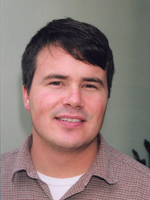On the Hunt for Tsunamis
Geologists Study OC, Region for Past Evidence
Feb. 22, 2012
Have large, devastating tsunamis ever hit Orange County’s and surrounding Southern California coastal areas? Not in recent times.
But perhaps thousands of years ago, say geologists Matthew E. Kirby and Brady P. Rhodes, who are conducting a pilot study to hunt for geological signs in sediment preserved in Southern California's wetlands to determine the region's tsunami history.
 Caption: Brady Rhodes
Caption: Brady Rhodes
“We’re trying to find evidence of past tsunamis,” said Rhodes, professor of geological sciences. “No written historical records exist in Southern California of any significant tsunamis affecting our coast. Historical written records extend back only 150 to 200 years.”
Scientists have used computerized, theoretical models to show that large tsunamis could have happened, said Kirby, associate professor of geological sciences. “So we’re saying, ‘Let’s go looking for them; let’s get some real geological evidence.’”
 Caption: Matthew Kirby
Caption: Matthew Kirby
The researchers recently received a $57,700 National Science Foundation Early-Concept Grant for Exploratory Research for “Search for a Paleotsunami Record in the Wetlands of California.” The study will include wetlands between Santa Barbara and the Mexican border, including Orange County.
The geologists have enlisted geology graduate and undergraduate students to assist them, including Fulbright scholar Khadija Nadimi from Pakistan, who holds a master's degree in geophysics and is working on a master’s in geology. Scientists from the U.S. Geologic Survey and the California Geologic Survey also are collaborating on the project.
If they find evidence of large tsunamis, “We’ll need more funding to do much study beyond this exploratory project,” Rhodes said.
Exploring Tsunamis History
Tsunami research is not new to the faculty members. Rhodes is a structural geologist whose expertise now includes tsunami geology, and Kirby studies prehistoric climate trends and sedimentology. For several years, both have traveled to Thailand to conduct tsunami research.
“We’re bringing our research experience from Thailand to Southern California,” said Rhodes. Currently, the pair is working on analyzing sediment samples from Thailand, in order to establish the history of tsunamis in the Indian Ocean.
In 2004, a 9.3 magnitude earthquake in the Indian Ocean off Sumatra triggered a tsunami that devastated the country and killed more than 220,000 people. Last year, a smaller magnitude 9.0 earthquake off the densely populated east coast of Japan triggered a tsunami of similar size, but with a much lower death toll. The reason, said Rhodes, is that Japan has a rich record, both geological and historical, of past tsunamis, providing important information that helped the country be better prepared.
Being more aware and equipped is the reason for Kirby and Rhodes’ research, which they say is not “doomsday science,” but a project that needs to be done and would potentially allow scientists to look back several thousand years into the past for evidence of tsunamis.
Southern California’s coastal wetlands were formed during the Holocene Epoch, the period between approximately 12,000 years ago and present day when the sea level rose from huge amounts of ice melting at the end of the last ice age. That period provided an ideal, predominantly muddy sedimentary environment to capture a sandy tsunami deposit, Rhodes said.
Finding a record of tsunamis in Southern California will verify and validate much of the research over the last decade on computer modeling of local tsunamis from underwater landslides and offshore earthquakes, Kirby explained.
Study’s Importance
The significance of their exploratory research is potentially far-reaching, said the researchers. Southern California’s densely populated coastal zone is home to three large ports, including the Port of Los Angeles and Long Beach Harbor, as well as 10 power plants, including the San Onofre nuclear power plant in Orange County.
“Even a modestly sized tsunami would have an enormous impact on the economy and people of Southern California,” Kirby said.
A geologic record of tsunamis would represent a “transformative scientific discovery that would help verify the occurrence, scale and frequency of inundation — critical information for planning tsunami hazard mitigation,” the geologists noted.
“Knowledge of our own tsunami history would help us prepare for the next one,” Kirby said.

